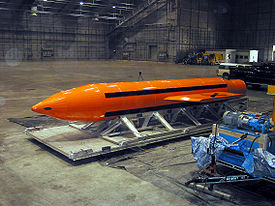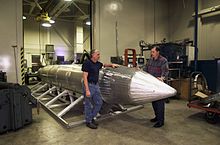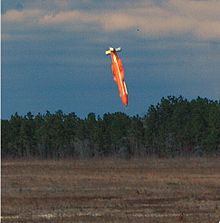- GBU-43/B Massive Ordnance Air Blast bomb
-
"MOAB" redirects here. For other uses, see Moab (disambiguation).
GBU-43/B Massive Ordnance Air Blast bomb 
Type Conventional Bomb Place of origin  United States
United StatesService history In service 2003–present Used by United States Air Force, Royal Air Force Production history Designer Air Force Research Laboratory Designed 2002 Manufacturer McAlester Army Ammunition Plant Produced 2003 Number built 17 Specifications Weight 22,600 lb (11.3 ton) Length 30 ft, 1.75 inches (9.17 m) Diameter 40.5 in (102.9 cm) Filling H-6 or Tritonal plus Fuel cocktail mix. Filling weight 18,700 lb (8.48 tons) Blast yield 11 tons GBU-43/B on display at the Air Force Armament Museum, Eglin Air Force Base, Florida. Note the grid fins.
The GBU-43/B Massive Ordnance Air Blast bomb (MOAB) (colloquially known as the Mother of All Bombs) is a large-yield conventional bomb developed for the United States military by Albert L. Weimorts, Jr.[1] At the time of development, it was touted as the most powerful non-nuclear weapon ever designed.[2] The bomb was designed to be delivered by a C-130 Hercules, primarily the MC-130E Combat Talon I or MC-130H Combat Talon II variants.[3]
Since then, Russia has tested its "Father of All Bombs", which is claimed to be four times more powerful than the MOAB.[4]
Contents
Development
The MOAB is an Air Force Research Laboratory technology project that began in fiscal year 2002, as a descendant of the BLU-82 "Daisy cutter". It underwent a successful field test at Eglin Air Force Base, Florida on March 11, 2003 and another on November 11, 2003.
Description
The designation "GBU" stands for Guided Bomb Unit. (Other types of bombs are designated as "BLU", for Bomb Live Unit, "BDU" for Bomb Dummy Unit, etc.) The "Guided" part of the designation indicates that it has a guidance capability to achieve significant accuracy at the desired point of impact.
The MOAB is 30 feet, 1¾ inches (9.17 m) long, has a diameter of 40½ inches (102.9 cm) and weighs 22,600 lb (10.3 tons), of which 18,700 lb (8.5 tons) is high explosive. Its blast radius is 450 feet (137 m, 150 yd), though the massive shock wave created by the air burst is said to be able to destroy an area as large as nine city blocks. Due to its large size and weight, it was designed to be dropped via parachute extraction out of the back of a C-130 cargo aircraft.
The MOAB is a precision guided munition which uses global positioning technology to impact at the target location. Detonation of the warhead is triggered by fuses on 4 foot long extenders on the nose of the weapon. It is the first U.S. weapon to use Russian-style lattice control surfaces (referred to as "Belotserkovskiy grid fins"),[5] like those used on the R-400 Oka and Vympel R-77.
The MOAB uses 18,700 pounds of H6 as its explosive filler.[6] At 1.35 times the power of TNT, H6 is one of the more powerful explosives used by the U.S. military. H6 is an explosive combination of RDX (Cyclotrimethylene trinitramine), TNT, and aluminum. H6 is typically employed by the military for general purpose bombs and is an explosive composition which is produced in Australia. H6 is a widely used main blast charge filling for underwater weapons such as mines, depth charges, torpedoes and mine disposal charges. HBX compositions (HBX-1, HBX-3, and H6) are aluminized (powdered aluminium) explosives mainly used as a replacement for the now obsolete explosive known as Torpex.[2] HBX-3 and H6 have lower sensitivity to impact and much higher explosion test temperatures than torpex. The warhead is designated the BLU-120/B.
Although its effect has often been compared to that of a nuclear weapon, it is only about one thousandth the power of Little Boy, the atomic bomb used against Hiroshima. The MOAB's blast is equivalent to around 11 tons of TNT, whereas the Hiroshima blast was equivalent to 15,000 tons of TNT; modern nuclear missiles are far more powerful than the atomic bomb used against Hiroshima. However, the MOAB bomb's yield is comparable to the smallest of nuclear devices, such as the M-388 Davy Crockett.
Operational history
It was first tested with the explosive tritonal on 11 March 2003, on Range 70 located at Eglin Air Force Base in Florida. It was again tested on November 21, 2003.[2] Aside from two test articles, the only known production is of 15 units at the McAlester Army Ammunition Plant in 2003 in support of Operation Iraqi Freedom. A single MOAB was moved to the Persian Gulf area in April 2003 but it was never used.[7] Since none of those are known to have been used as of early 2007, the U.S. inventory of GBU-43/B presumably remains at approximately 15.
Evaluations
The basic operational concept bears some similarity to the BLU-82 Daisy Cutter, which was used to clear heavily wooded areas in the Vietnam War and in Iraq to clear mines and later as a psychological weapon against the Iraqi military. After witnessing the psychological impact of the BLU-82 on enemy soldiers, and not having any BLU-82 weapons remaining, the MOAB was developed partly to continue the role of intimidating the Iraqi soldiers. Pentagon officials had suggested their intention to use MOAB as an anti-personnel weapon, as part of the "shock and awe" strategy integral to the 2003 invasion of Iraq.[8]
The MOAB is not a penetrator weapon and is primarily intended for soft to medium surface targets covering extended areas and targets in a contained environment such as a deep canyon or within a cave system. However, multiple strikes with lower yield ordnance may be more effective and can be delivered by fighter/bombers such as the F-16 with greater stand-off capability than the C-130 and C-17. High altitude carpet-bombing with much smaller 2,000 or 1,000 pound bombs delivered via B-52s is also highly effective at covering large areas.[9] However, the psychological warfare effect of a MOAB blast can significantly reduce an opponent's desire to resist.
See also
- Grand Slam bomb
- Massive Ordnance Penetrator
- T-12 Cloudmaker
- BLU-82
- JDAM
- Soviet atomic bomb project
- Tsar Bomba
Notes
- ^ Times Wire Services (2005-12-27). "Albert L. Weimorts Jr. 67; Engineer Created 'Bunker Buster' Bombs". Los Angeles Times. http://articles.latimes.com/2005/dec/27/local/me-passings27.3. Retrieved 2010-07-08.
- ^ a b c GBU-43/B / "Mother Of All Bombs" / Massive Ordnance Air Blast Bomb
- ^ GBU-43/B "Mother Of All Bombs", MOAB - Massive Ordnance Air Blast Bomb
- ^ Luke Harding (2007-09-12). "Russia unveils the 'father of all bombs'". Guardian Unlimited. http://www.guardian.co.uk/russia/article/0,,2167175,00.html. Retrieved 2007-09-12.
- ^ Zaloga, Steve (2000). The Scud and Other Russian Ballistic Missile Vehicles. New Territories, Hong Kong: Concord Publications Co. ISBN 962-361-675-9.
- ^ jagcnet (DOC)
- ^ MOAB bomb moved to Iraq war region
- ^ "Enter MOAB". National Review Onlone. 2003. http://www.nationalreview.com/owens/owens031203.asp. Retrieved 2008-03-23.
- ^ "United States Military Weapons of War". about.com. 2007. http://usmilitary.about.com/od/weapons/l/aabombs4.htm. Retrieved 2007-12-09.
External links
Categories:- Aerial bombs of the United States
- Superbombs
- Guided bombs
Wikimedia Foundation. 2010.



